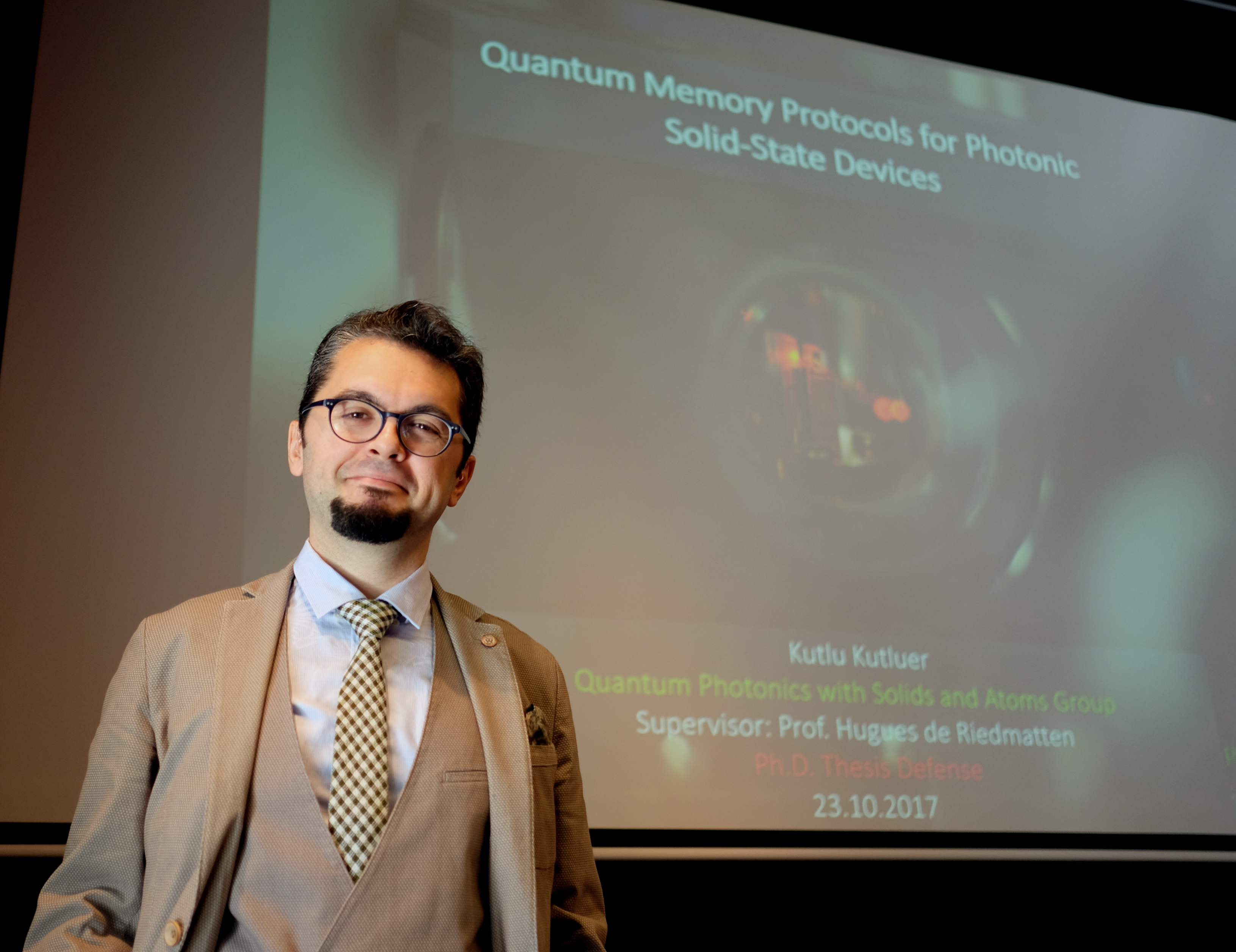23 October 2017


Dr. Kutlu Kutluer has successfully defended his thesis titled “Quantum Memory Protocols for Photonic Solid-State Devices”. Kutlu is the fifth PhD graduate from our group. We congratulate Dr. Kutluer and wish him success in his future life!
(thanks)
Abstract
A photonic quantum memory (QM) is a device that has the capability of storing a quantum state of light and retrieving back after a controlled time. It is an important element in quantum information science and is, among other applications, a crucial device for quantum repeater architectures which have been proposed to overcome the loss and the decoherence issues in long distance transmission of photons. Rare earth ion doped solid state systems are promising candidates for QMs which combine the advantages of solid state systems, such as scalability and reduced experimental complexity, with the long coherence time typically found in atomic systems. In this thesis, I investigated three different QM protocols in a Pr3+:Y2SiO5 crystal.
The first part describes here the first demonstration of the spectral hole memory (SHoMe) protocol which was proposed theoretically in 2009. This protocol relies on slowing down the light in a long-lived spectral hole and transferring the excitations to the spin state. We first prepare a spectral hole, then send an input pulse whose bandwidth is comparable with the hole and stop the compressed light in the crystal by transferring the off-resonant coherence to the spin state with an optical π pulse. Later a second π pulse transfers the coherence back and leads to the emission of the stored light. We reached a storage and retrieval efficiency of around 40% in the classical regime, and of 31% in the single photon level, with a signal-to-noise ratio of 33 ± 4 for a mean input photon number of 1. These results demonstrate the most efficient and noiseless spin-wave solid-state optical memory at the single photon level to date.
The second part of the thesis describes new experiments using the well-known atomic frequency comb (AFC) protocol. It is based on tailoring the inhomogeneously broadened absorption profile of the rare earth with periodic absorptive peaks, which induces the re-emission of the absorbed light field after a certain time determined by the separation between the peaks. In this chapter I describe several AFC experiments. First I present the storage of frequency converted telecom photons into our crystal where we obtained a total efficiency of 1.9 ± 0.2 % for a storage time of 1.6 μs storage time and signal-to-noise ratio of more than 200 for a mean input photon number of 1. Then I discuss the results of improved excited state storage efficiency values for long storage times where we achieved 30% at short storage times and up to 17% at 10 μs storage time. And finally I present a spin-wave AFC experiment where we obtained a signal-to-noise ratio value of 28 ± 8 for a mean input photon number of 1, the highest value achieved so far for this kind of experiment. Finally, in the last part, I describe the first demonstration of a solid-state photon pair source with embedded multimode quantum memory. The aim of the protocol is to combine a single photon source and a QM in one ensemble as in the well-known Duan-Lukin-Zoller-Cirac (DLCZ) scheme however this time not in a cold atomic ensemble but in a solid-state crystal.
The protocol takes advantage of the AFC protocol for rephasing the ions and obtaining efficient read-out. The use of AFC also makes the protocol temporally multi-mode. In the experiment, after the AFC preparation we send an on-resonant write pulse and detect the decayed Stokes photons which herald single spin excitations. At a later time a read pulse transfers the spin excitation back to the excited state and we detect the anti-Stokes photons. We show strong non-classical second order cross-correlations between the Stokes and anti-Stokes photons and demonstrate storage of 11 temporal modes.
The results presented in this thesis represent a significant contribution to the field of solid-state quantum memories and an important steps towards the realization of scalable quantum network architectures with solid state systems.
